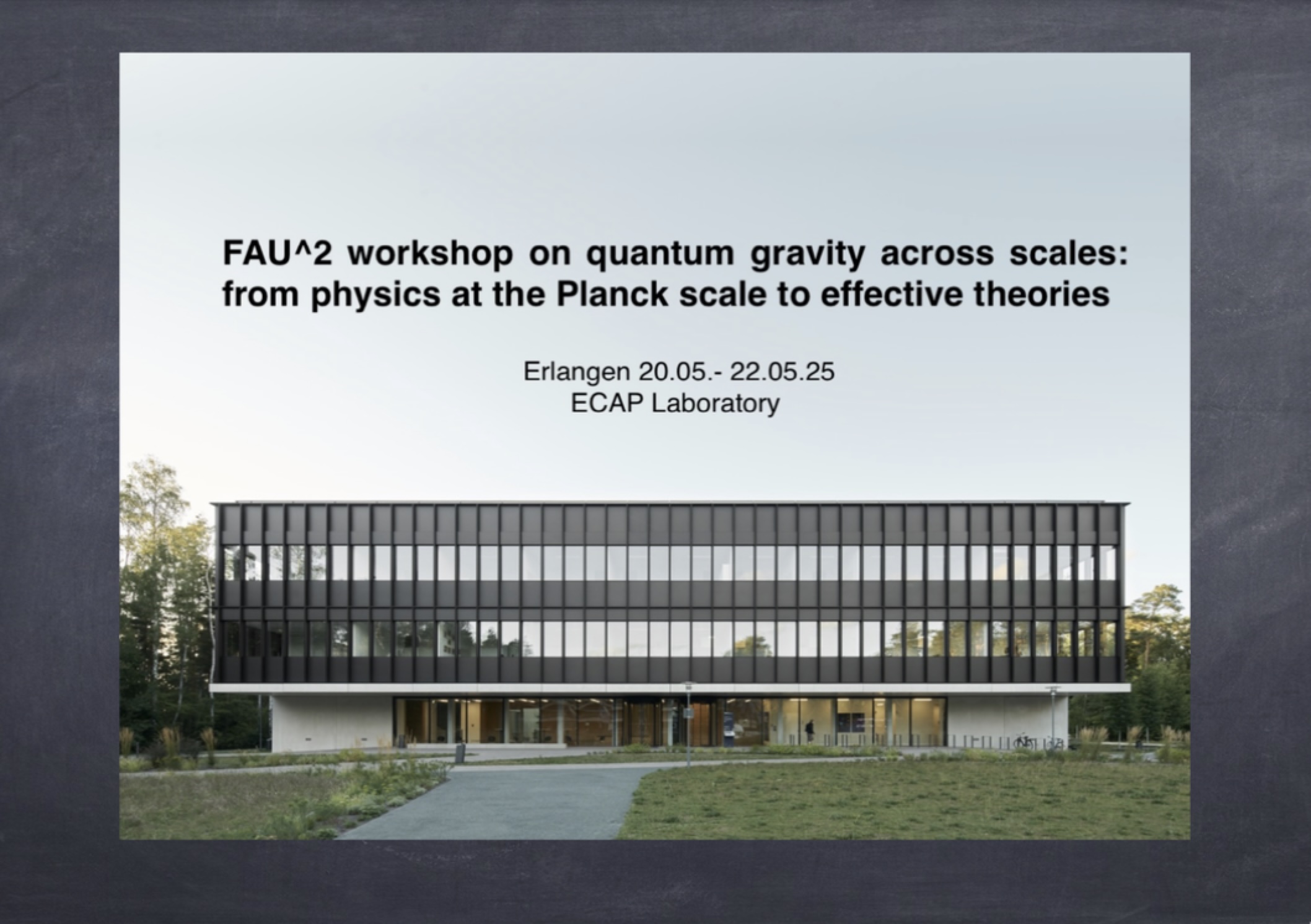- Indico style
- Indico style - inline minutes
- Indico style - numbered
- Indico style - numbered + minutes
- Indico Weeks View
FAU^2 Workshop on quantum gravity across scales: from physics at the Planck scale to effective theories
→
Europe/Berlin
ECAP Laboratory Building
ECAP Laboratory Building
Nikolaus-Fiebiger-Straße 2
91058 Erlangen
Description

Quantum gravity seeks to reconcile general relativity with quantum field theory, providing a consistent description of spacetime at all energy scales. This workshop aims to explore the interplay between different approaches of quantum gravity at the Planck scale, such as for instance canonical and covariant loop quantum gravity, group field theory and asymptotically safe gravity, and their corresponding low-energy effective descriptions. We aim to discuss how characteristic properties at the Planck scale might leave an imprint in the effective description of gravitational phenomena at macroscopic scales. Main topics include the application in cosmology and the gravitational collapse, modified gravity and the role of physical (quantum) reference frames in the effective description. By bringing together experts from different areas of quantum gravity, one of the main focuses of the workshop is on comparing different methods for accessing the low-energy sector and analysing possible physical implications of quantum gravity across different scales.
List of confirmed invited speakers:
Ana Alonso-Serrano (HU Berlin & AEI MPI for Graviational Physics Golm)
Alfio Bonnano (INAF & INFN Catania)
Astrid Eichhorn (Universität Heidelberg)
Johanna Erdmenger (Julius-Maximilians-Universität Würzburg)
Kevin Falls* (Universidad de la Republica Montevideo)
Markus Fröb (Universität Leipzig)
Philipp Höhn* (Okinawa Institute of Science and Technology)
Hongguang Liu* (Westlake University, Hangzhou)
Guillermo Mena Marugan (IEM Madrid, CSIC)
Daniele Oriti* (Universitdad Complutense de Madrid)
Frank Saueressig* (Radboud University Nijmegen)
Parrampreet Singh* (Louisiana State University)
Sebastian Steinhaus (Universität Jena)
Thomas Thiemann (FAU Erlangen-Nürnberg)
*remotely.
Organizers: Renata Ferrero, Kristina Giesel and Muxin Han


Registration
Participants
Participants
Alfio Bonanno
Ana Alonso-Serrano
Ashay Sathe
Astrid Eichhorn
Daniele Oriti
Diego Buccio
Eric Rullit
Francesco Fazzini
Guillermo A. Mena Marugán
Hanno Sahlmann
Ibai Asensio
Idrus Husin Belfaqih
Ilkka Mäkinen
Jingqian Gou
Johanna Erdmenger
Johannes Thürigen
Kai Langer
Kevin Falls
Kristina Giesel
Luca Cafaro
Luca Marchetti
Marc Schiffer
Markus Fröb
Martin Zeiss
Matteo Bruno
Mehdi Assanioussi
Melissa Rodriguez Zarate
Michał Bobula
Moaathe Belhaj Ahmed
Muxin Han
Oliver Friedrich
Parampreet Singh
Paul Hartung
Philipp Hoehn
Renata Ferrero
Roberto Percacci
Roman Kemper
Roukaya Dekhil
Sebastian Steinhaus
Sofie Ried
Thiago Lucena De Macedo Guedes
Thomas Thiemann
Varun Kushwaha
Vesselin Gueorguiev
Wolfgang Wieland
